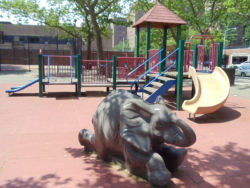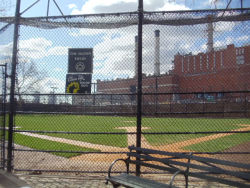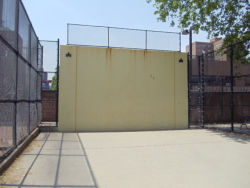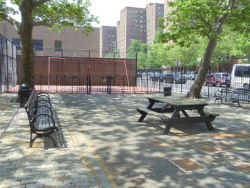Murphy Brothers Playground
Murphy's Brother's Playground
What was here before?
The area where this park is located was once called the Gas House District, named because of gas storage tanks lining the eastern waterfront, including two giant circular gas storage tanks off Avenue C between East 15th and East 16th Streets. Although there were occasional gas leaks from the plant, the neighboring tenements were home to many arriving European immigrants looking for affordable housing. By the 1930s, most of the gas tanks were removed and the sites cleaned up. This was the beginning of the urban renewal project that razed eighteen city blocks and led to the development of nearby Stuyvesant Town and Peter Cooper Village by the late 1940s.
How did this site become a playground?
The City of New York acquired the land by 1861, and the Department of Docks and Ferries filled and improved it in 1893. In 1903, the parcel was transferred to the Department of Parks, and it was planted, fenced, and turned into a playground. During its early years, the site was known as East 17th Street Park.
In 1921 the Board of Aldermen named the park for politician and businessman John J. Murphy (1865-1911). A 1930s plan of the park included a fully developed playground surrounded by an iron picket fence, lawn space, curving walks, and an open pavilion. The eastern parcel was backfilled during construction of the East River Drive in 1938 and officially transferred to Parks in 1947.
The park was reconstructed in 1994 with new ballfields, a basketball court, playground equipment, hopscotch squares, benches, safety surfacing, pavements, and curbs. The playground was rededicated this time to celebrate two Murphy brothers: Charles Francis and John J.
The waterfront park reopened following construction in 2024 with new flood protection, a basketball court, two new ballfields, two new dog runs, a new playground area, and new grading and landscaping.
Who is this playground named for?
Businessman John J. Murphy was the son of Irish immigrants, and one of eight brothers and sisters raised on the east side of Manhattan. He served as an alderman and the acting Democratic leader of the 12th Assembly District. Murphy made his fortune as president of the New York Contracting and Trucking Company, which had a contract to excavate the site for Penn Station. His good fortune in business and politics resulted in large part from his older brother, Charles Francis Murphy (1858-1924), the leader of Tammany Hall.
Charles Murphy attended local public schools until he was fourteen and formed the Sylvan Social Club for boys. After working at wire factories, in a shipyard, and on the Blue Line streetcars, Murphy opened his first saloon in 1878. Serving a bowl of soup and a beer for a nickel, his various saloons were social centers in the Gas House District. Murphy established himself as a friend and adviser of neighborhood workers and politicians, and he quickly rose as a popular and powerful political player in his own right.
Having backed several candidates from Tammany Hall, Charles Murphy was made election district captain for the Democratic organization. He earned a series of appointments, including leader of the 18th Assembly District (1892) and Dock Commissioner (1898). Named to the Tammany Hall Triumvirate of Executive Committee Members in May 1902, Murphy became Tammany’s sole leader four months later. Known as “Silent Charlie”, he brokered agreements between warring parties in his organization and helped numerous Tammany candidates win city, state, and national offices. Six years after his death in 1924, the Charles F. Murphy Memorial Flagpole, also known as the Independence Flagstaff, was dedicated in Union Square.
Check out your park's Vital Signs
Clean & Safe
Green & Resilient
Empowered & Engaged Users
Share your feedback or learn more about how this park is part of a
Vital Park System






